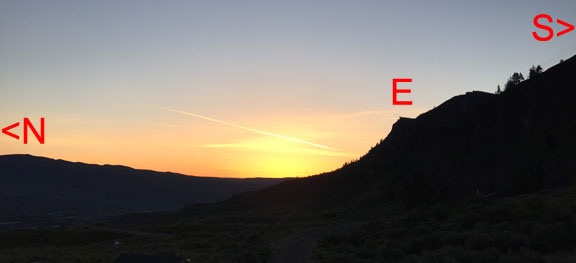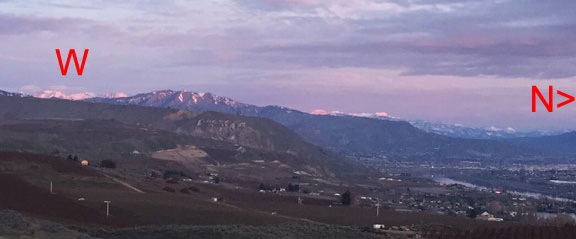When first light is first light.
For the past 20 or years, I’ve lived in a place where I could see the horizon and watch the sun rise and set. This wasn’t the case when I lived in New Jersey or New York, in places surrounded by either tall trees or other buildings. It’s nice to see the horizon, to greet the sun when it makes its first appearance for the day, to see the way first light touches the landscape around me, to watch weather move through, to see last light and watch the sun dip below the horizon at the end of the day.
The sun, in a way, is my clock. Not having a scheduled life, I let it tell me when to get up in the morning and, during long summer days, often go to sleep not long after it sets.
I live at the base of some tall cliffs on a hillside overlooking the Wenatchee Valley and Columbia River. The cliffs are to the south of me — the view from my home is about 180°, basically from east to to north to west. To the east, the cliffs rise up from the east to their full height due south.

The horizon, as shot from my front deck before dawn this morning. The E marks the point that is approximately due east.
During the winter, when the sun is low in the sky and rises more to the south — remember, I’m in Washington State at about 47° latitude — there’s a 6-week period when the sun doesn’t even clear the cliffs at my place (although it does shine down in the valley). I call that the Shadow Time and blogged about it here.
As the days get longer, the sun shifts north, eventually, at the spring equinox, rising due east. As long as it rises behind the cliffs, I don’t get direct sun until after it clears the tops of the cliffs. But this week, about 3 weeks after the first day of spring, the sun began rising far enough north that it appears at what I think of as the true horizon — the place where the horizon isn’t blocked by nearby hills or cliffs. From that point on, I see the sun when it makes its first appearance of the day — and will continue to see sunrise until about three weeks before the autumn equinox.
If all this is meaningless to you, you should explore some of the excellent articles on the web that explain the sun’s movement in the sky and seasons. Here are a few links to get started:
- Understanding Astronomy: The Sun and the Seasons
- The Sun’s surprising movement across the sky
- How does the Sun appear to move across our sky in the Northern hemisphere?
- Sun Position Calculator
Astronomy is a lot more than stars and constellations. Just saying.
Since I have a name for the time when there’s no direct sun (Shadow Time), I thought I needed a name for the time when I can see the sun rise out of the far horizon. I’ve decided to call it Dawn Time.
If there’s a corresponding Sunset Time — the time I can watch the sun set into the far horizon — that would probably be a bit before the spring equinox. I can see due west from my home — the snow covered peaks of the Enchantment Range out beyond Leavenworth — and that’s where the sun’s setting these days.

I shot this photo at first light from my side deck a few weeks ago. The sun touches the mountaintops to the west before it rises high enough to shine into the valley. This is probably my favorite part of sunrise.
But for some reason, I’m more interested in sunrise, the start of the day, than sunset. I’m a morning person, through and through and get my best work done before noon. By 5 or 6 PM, I’m pretty much spent. That’s when it’s nice to sit out on the deck with a glass of wine and watch the sun set — and the light show that often goes with it.
Discover more from An Eclectic Mind
Subscribe to get the latest posts sent to your email.

You have those great wide vistas and your air is clear. I live in the UK in a rural area at 52 degrees N in a small hollow of fields surrounded on all sides by wooded hills. The light is more ‘oblique’, like central BC to your North. The house has the exact opposite orientation to yours. The main rooms look SSW and the hills in front mean that the sun sets at 15.00 GMT on 21st December. We have high rainfall so the land is nearly almost as green as Ireland.
I sometimes look at your weather station data (fascinating to compare). Your winter was cold and dry for a long spell, whereas we had few frosts and much rain (5 inches in January, 4.5 in March)
But the return of the sun before breakfast is always a delight. I used to have to get up at 05.00 to walk the dogs before heading off for work. Easy in June but a real struggle in January. In late June last year I trimmed my garden hedge at 22.30 with quite enough natural light to complete the job.